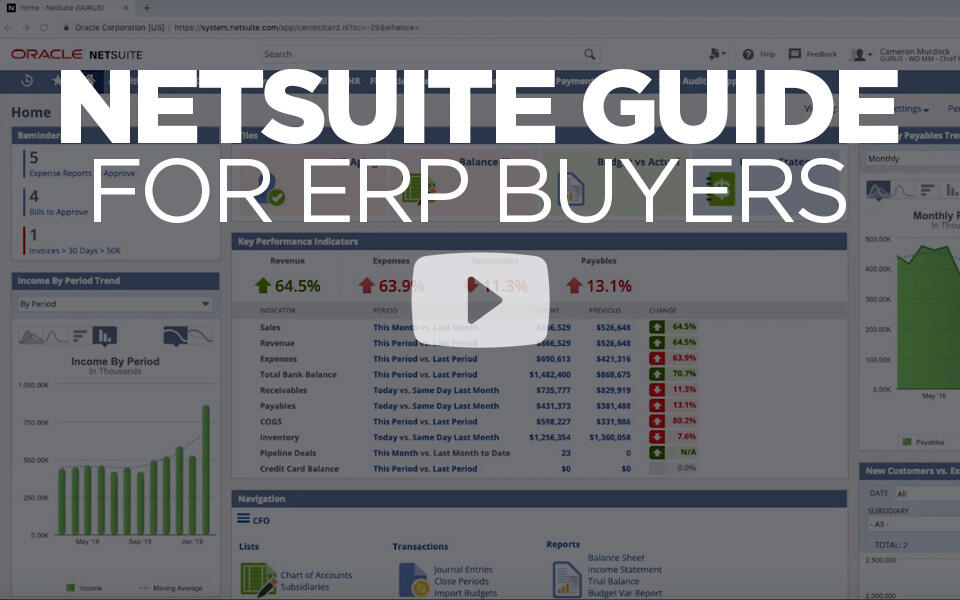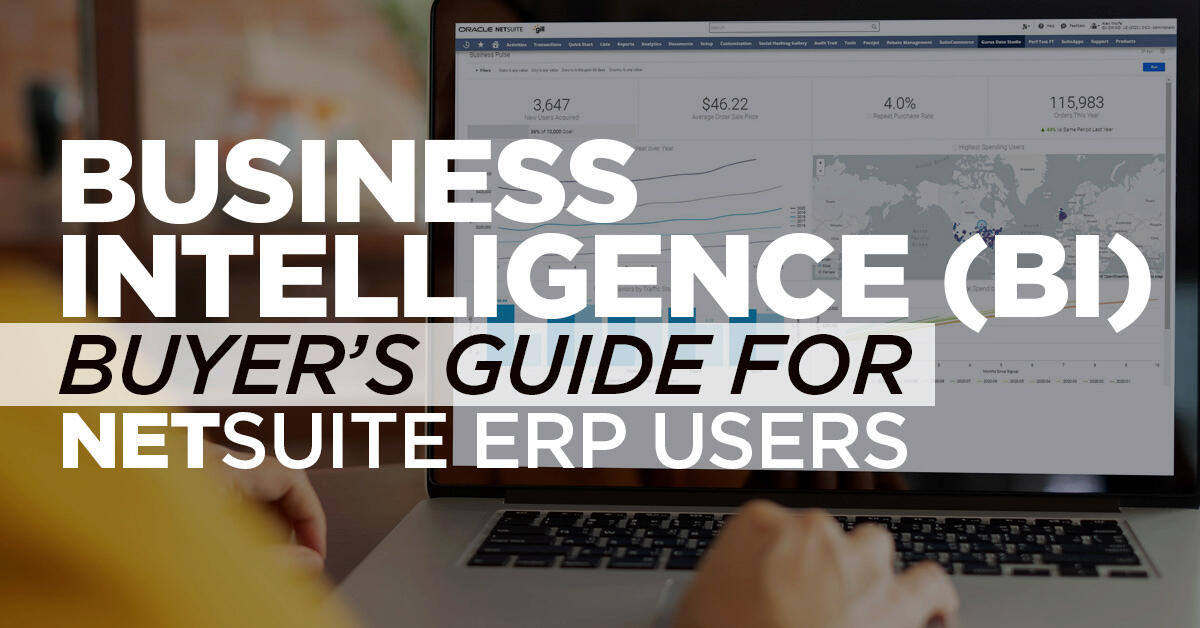
Welcome to our comprehensive Buyer’s Guide for NetSuite BI Tools. In our last article, I talked about how BI (Business Intelligence) works with NetSuite ERP, including the history behind common industry buzzwords like “BI”, “AI”, what a business intelligence tool does, which types of companies can use it, and more.
In this guide, I will be walking you through existing business intelligence tools for your ERP and some of the ways in which your business can leverage data analytics and data visualization with a tool like Business Intelligence for NetSuite, Powered by GURUS. If you’re looking to upgrade your current reporting tools with a BI solution and leverage data warehousing or pull all of your integrated application analytics into NetSuite for a wide overview, this should help you in making the right decision for your business.
Request More Info From an Expert
Addressing Data Challenges with Mid-Sized Organizations
Executives are making decisions everyday based on the information that they have at their disposal. That information is being gathered from multiple data sources - both from the enterprise systems that capture everyday transactions that make up their business and from the unstructured sources living in varying information repositories and in people’s heads.
As a result, many organizations are reactive in their decision-making and are ultimately basing their corporate strategies on piecemeal and outdated information, limiting their ability to steer their businesses in the right direction.
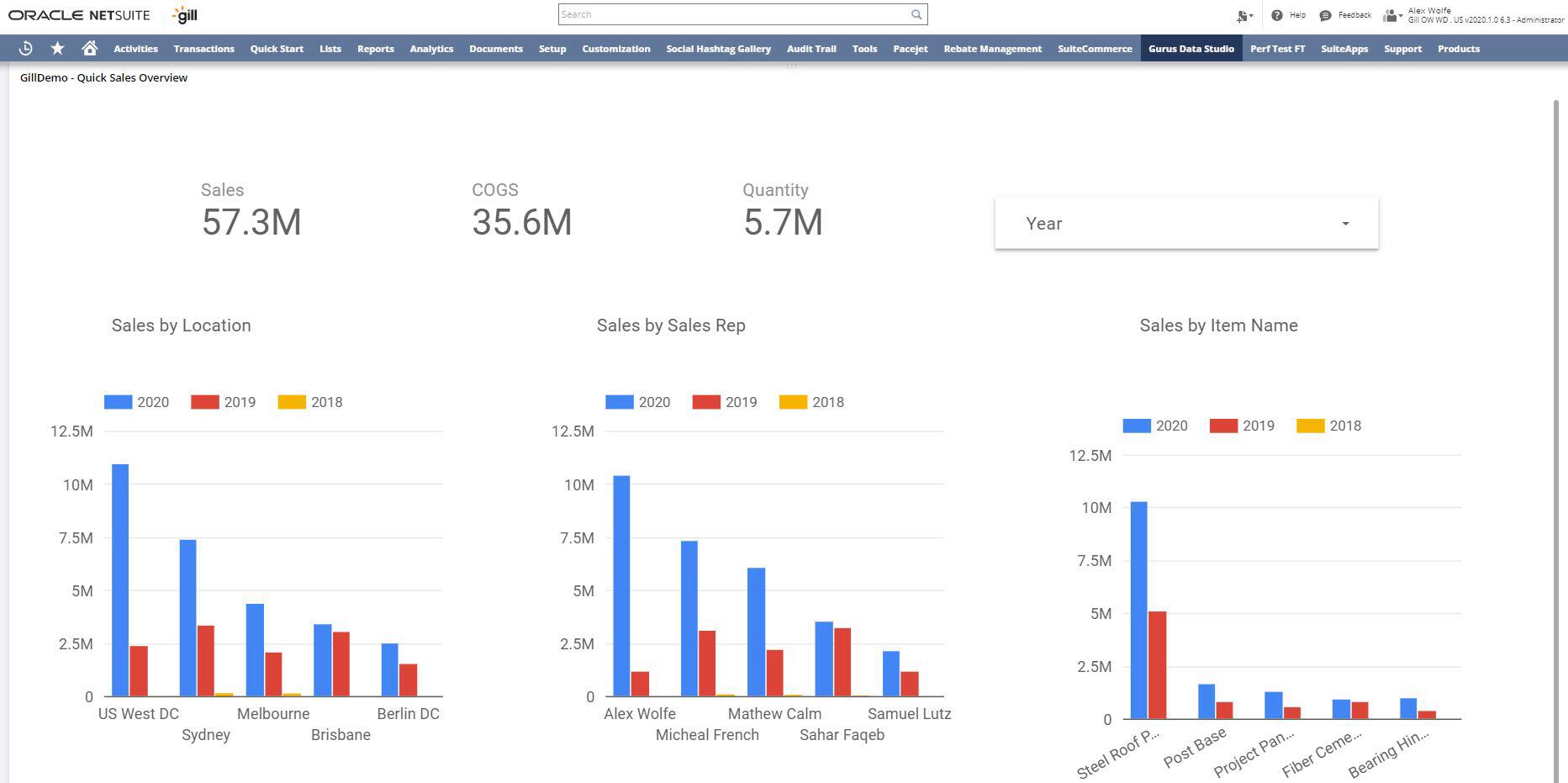
Screenshot of Business Intelligence for NetSuite, Powered by GURUS.
NetSuite ERP’s Analytics Offering
NetSuite ERP has provided unprecedented access to information to mid-sized organizations. Providing a cloud-centric approach to capture all mission-critical data, businesses running on the NetSuite platform, along with its robust cloud ecosystem of partner solutions, have quickly recognized the incredible amount of information at their fingertips.
With SuiteAnalytics, there are a number of excellent options to generate reports natively from the system. NetSuite offers out-of-the-box financial reporting in which users can customize or create their own custom reports from scratch.
Check Out Our Complete NetSuite ERP Walkthrough
Using the same reporting engine, hierarchical reporting with custom columns, filters and formulas are available. For spreadsheet-like reports, Saved Searches can be created offering flexible highlighting options, filters, dashboard push reminders, formulas and in-line editing options. Both these options have extract options in a variety of file formats and the ability to be displayed in dashboard views.
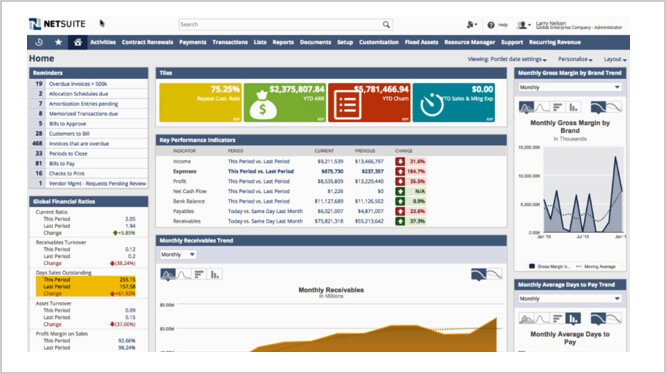
More recently, the Workbook analytics option has been gaining traction allowing NetSuite users to leverage more typical visualizations capabilities, such as pivot table creation, more charting options and separate data sets to better manage report creation.
Although NetSuite’s reporting toolsets are excellent in delivering flexible and user-friendly reporting in comparison to other Enterprise Resource Planning systems, the challenges still remain when more complex Business Intelligence (BI) requirements emerge.
Where Business Intelligence (BI) for ERP comes into the Picture
Like any best of breed ERP system, NetSuite is designed to facilitate business execution by ensuring transactions are efficiently reviewed, processed, and posted. Reporting and analytics within the ERP system serve to facilitate the maximum benefit of the system at hand.
Although the ERP tends to be the primary system of record, businesses undoubtedly rely on other enterprise systems, as well as third party applications and processes to successfully serve their customers, suppliers and partners.

Consequently, organizations that seek to optimize their current data sets to develop strategic analytics across systems and processes quickly face challenges in effectively visualizing and exploring the unique data points that drive their strategic business decisions. In order to address these challenges, businesses seek ways to extract their data in other tool sets to deliver the important information executives crave.
As the strategic reporting needs are stretched to their limits in spreadsheets and the existing tool sets at hand, the decision to establish a Business Intelligence strategy inevitably enters the forefront. That’s where BI for NetSuite ERP comes into play.
Business Intelligence Buyer’s Guide for NetSuite
More than ever, Mid-Market companies have embarked on a journey towards “BI Nirvana.” For ERP users looking for the right tool that will work cohesively as a NetSuite add-on, here are some of the main considerations to take into account when evaluating Business Intelligence solutions for your current system.
Step 1: Carefully identify your business pain
- Determine the severity of the business pain
Is it localized or across the organization? BI initiatives tend to gain more traction when multiple groups in an organization experience similar challenges in exploring their data. - Validated your company’s BANT What is BANT?
It stands for Budget, Authority, Need and Timeline. These are the core factors that should drive your decision-making process to evaluate new BI technology. These factors need to be assessed in order to determine going down the arduous evaluation journey of a business intelligence solution that will heavily impact your company.

- Understand the identified business pain and the skill set to solve it. BI initiatives can range in scope. Hence, clearly defining the parameters of what needs to be addressed and developing a plan on who will support (internal sources vs. external/partner support) the new technology is critical to a successful solution.
- Identify the limits of your existing ERP system and its impact on your BI strategy. A solid understanding of the inner working of the business analytics platform capabilities of your current ERP system will help better define where the true gaps lie and where BI can add the most value to your reporting. Moreover, researching integration options and case studies with other BI solutions, as well as your current ERP should be factored into the equation. You should be able to have insight into the best suitable options for your current environment.
Step 2: Do your homework before engaging solution providers
- Build a team of champions to develop a research strategy in seeking the best solution and partner. This exercise will ensure that you gain multiple perspectives on your business process pain(s), while simultaneously maximizing your organization’s knowledge to make an informed decision.
- Leverage your network to provide referrals and/or recommendations. Speaking to internal resources, partners and customers will provide the unvarnished truth of the available options. This will facilitate more fruitful discussions with potential solution providers and their available NetSuite Data and BI tools.
- Understand your Market and the available BI Software options. Engage with 3rd party research firms and immerse yourself in online resources (blogs, articles, videos, forums, etc.) to build your team’s knowledge of the market space. The idea is to go beyond the marketing messages and get a clear understanding of the available capabilities of potential solution providers.
- Build a desired System Architecture - comparing current state to future state. A BI system integration initiative typically touches multiple other systems in your organization. Understanding the primary system of record and the related systems feeding your BI solution will guide your organization in the possible solutions to evaluate.
- Develop an ROI and TCO Analysis strategy - when building the business case for the benefits BI can deliver your organization. Tangible numbers will provide visibility on the necessary funds required for your BI investment. This analysis exercise can also inform the integration investment you may want to explore (e.g. Middleware Vs. Point-to-Point options).
Step 3: Formalize your evaluation approach
- Identify the evaluation team to ensure company buy-in. Building a team with right knowledge and influence is key to any successful software selection process. Not only will it ensure “No stone is left unturned,” but it will also secure the necessary stakeholders to finalize the purchase.
- Develop a requirements document to share with potential solution providers. Requirement documents need to easily provide a detailed picture of your BI needs. This document needs to serve as a communication tool between your business and the potential solution providers.
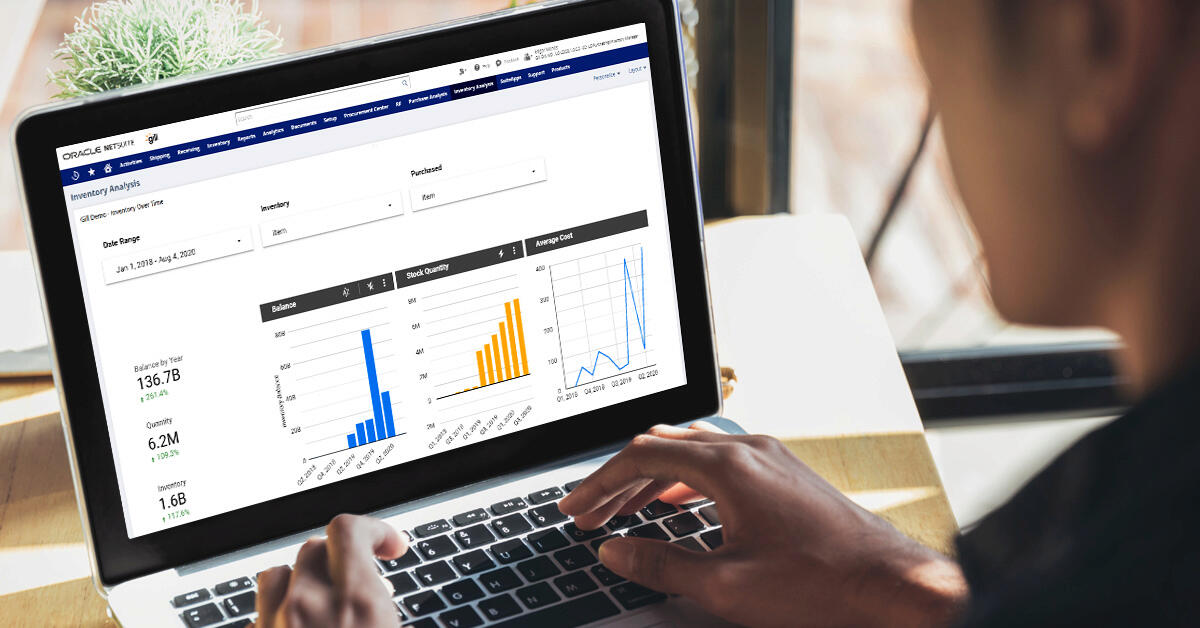
- Create a rating system to ensure an “Apples to Apples” comparison between all the BI solution options. Ratings should include functionality, compatible technology, integration, expertise, and service delivery (response time). This will balance the evaluation process and mitigate the “Loudest voices in the room” skewing the evaluation process.
- Develop a plan and relevant milestones to engage with potential providers. The evaluation of a significant decision in selecting a BI solution needs to be treated as a project in itself. As the expression goes, “By failing to prepare, you are preparing to fail.”
- Plan concise discovery sessions and a centralized repository to capture provider details (e.g. RFI/RFP) with your long list. Formalize the capture of supplier responses, schedule follow up clarification call and centralize the information for stakeholder review of the potential pool of candidates.

Step 4: Select the BI Solution to best meet your needs
- Schedule deeper discussions and scripted demos with success criteria for your short list candidates. Upon further review and analysis of the captured information, whittle down your list of potential providers to a manageable 3-5 candidates. As part of this process, schedule scripted demos to your shortlist to validate and finalize your purchase.
- Setup a validation strategy with your selected potential solution provider. Run through a final review of the proposed solutions and the accompanying implementation strategy. Don’t forget to include relevant data migration and integration strategies as part of your review process.
- Review, analyze and score RFI/RFP responses along with demoed solutions. This needs to be a collaborative effort among the selection team and all the stakeholders involved. This exercise should strengthen change management challenges that lay ahead with the newly implemented BI solution.
- Validate cost, services and support expectations. Confirm there are no hidden costs and the SLA (Service Level Agreement) meets your expectations. There is nothing worse than discovering “after the fact” limitations to your support and service agreement in a BI project that will impact your day to day business.
- Review the final proposal and negotiate the final terms. Make sure you read the fine print and understand what your organization is signing up for. Terms should be balanced and protect both parties involved in your BI project.
How Business Intelligence for NetSuite, Powered by GURUS, can help your business
A growing number of mid-market companies are realizing that they can build out a sophisticated Business Intelligence strategy without needing to invest millions of dollars. With cloud-based systems facilitating scaleable system infrastructures, a platform like NetSuite makes it easy to reduce costs while taking advantage of modern BI technology.
At the same time, there are countless mid-sized companies that struggle with getting the right data analysis to grow, despite having years of data residing in the cloud. The purpose of a NetSuite Data Tool like Business Intelligence for NetSuite, Powered by GURUS, is to provide an affordable and low maintenance platform to house large data sets and generate powerful analytics with multiple visualization solutions available to you (Looker, Power BI for NetSuite, Tableau, etc).
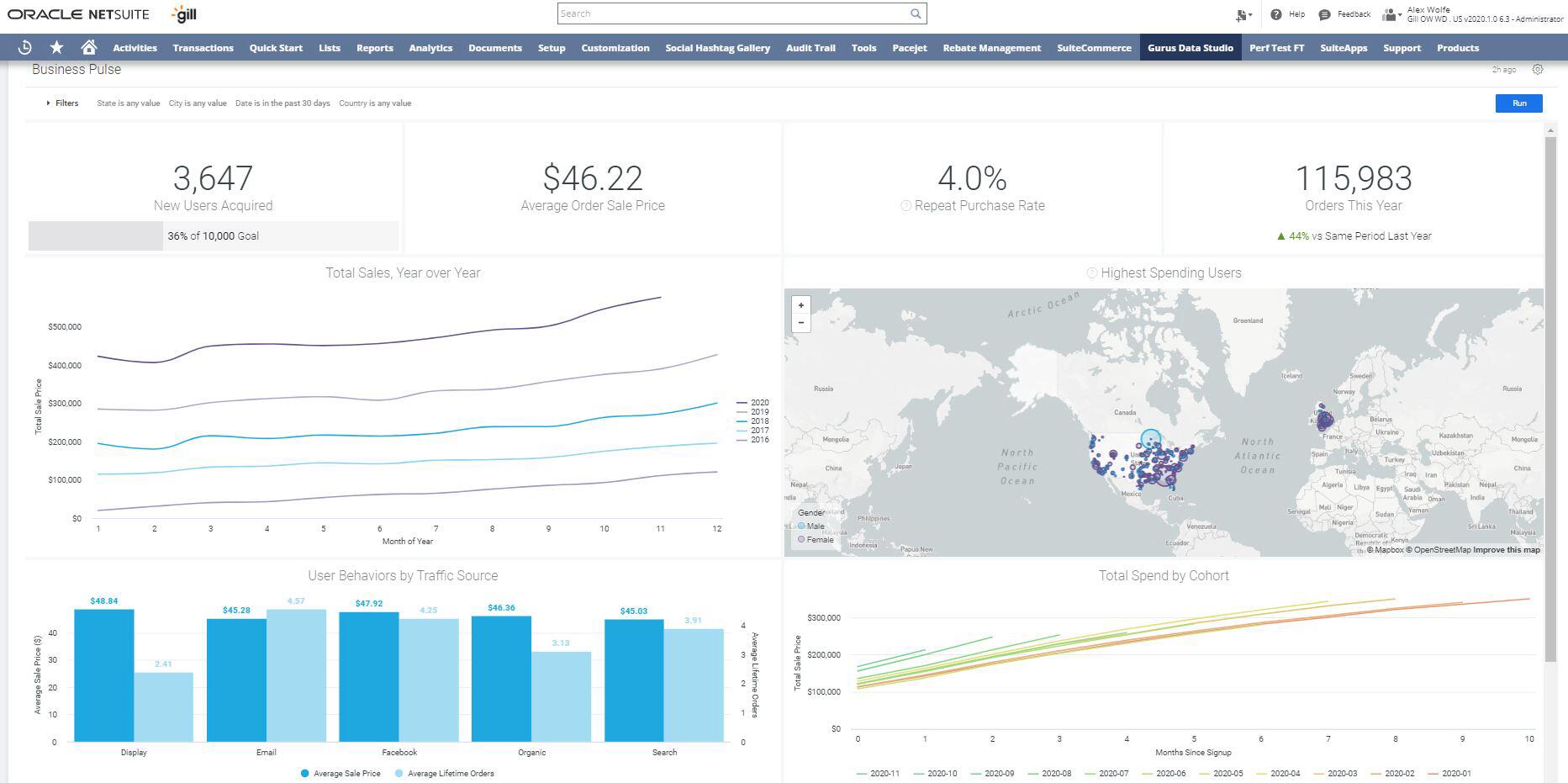
Screenshot of Business Intelligence for NetSuite, Powered by GURUS, with an embedded view of Looker’s visualization tools

Our add-on business intelligence for NetSuite is geared to leverage powerful tools like Google BigQuery, Google’s Data Studio, and more.
The challenge remains in effectively aligning ERP data with these systems. Consequently, ERP service providers are a necessary component in building an effectively integrated business intelligence solution for mid-market organizations.
For most businesses interested in taking on BI data tools, they do not have the ERP data model knowledge to build out a truly impactful business intelligence system for their business. Fortunately, NetSuite and Google have a strong partner ecosystem to bridge the gap between BI and ERP.
To learn how GURUS solutions can help your company implement BI for NetSuite ERP, please check out our latest NetSuite BI Solution.

